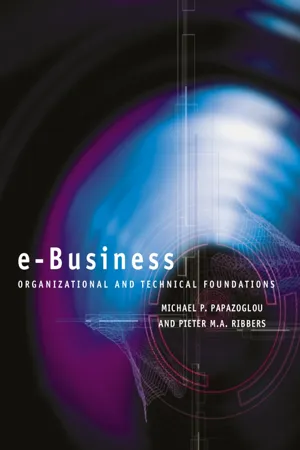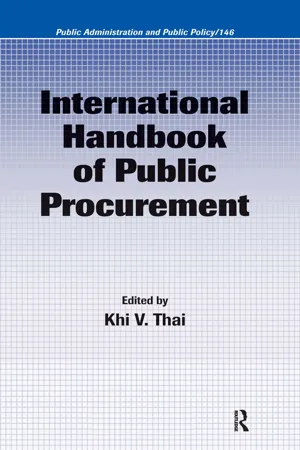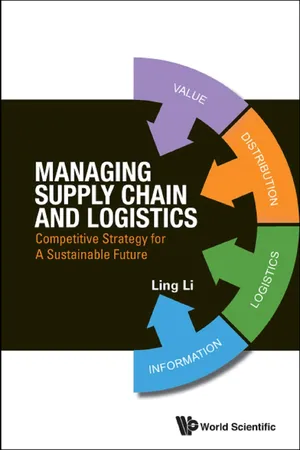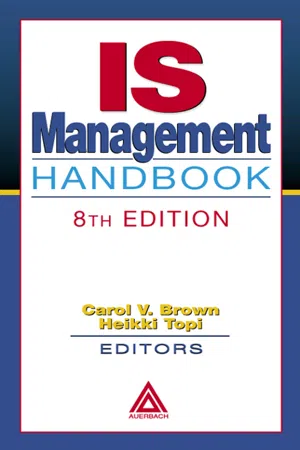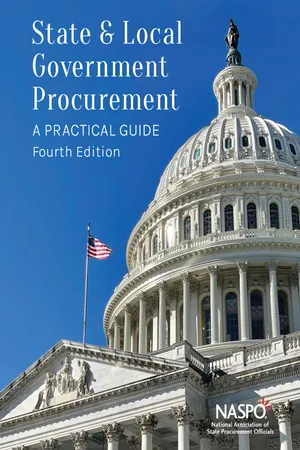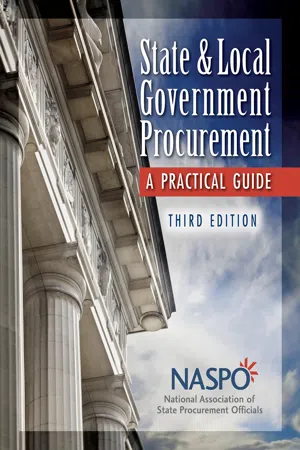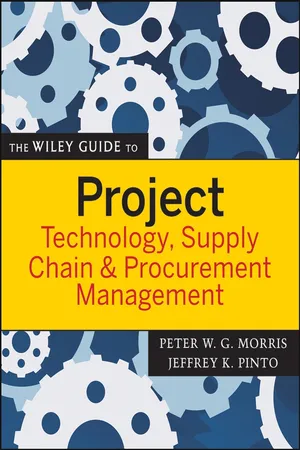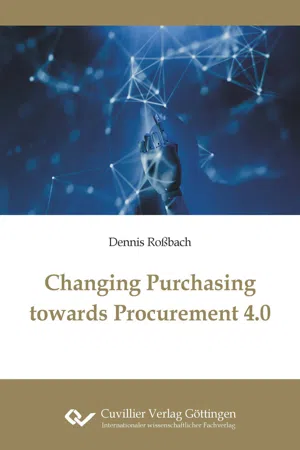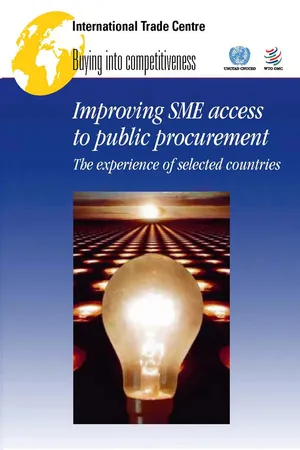Marketing
E procurement
E-procurement refers to the use of digital technology for purchasing goods and services. It streamlines the procurement process by automating tasks such as supplier management, sourcing, and purchase order processing. This can lead to cost savings, improved efficiency, and better supplier relationships.
Written by Perlego with AI-assistance
Related key terms
1 of 5
12 Key excerpts on "E procurement"
- eBook - PDF
- Paul Beynon-Davies(Author)
- 2017(Publication Date)
- Red Globe Press(Publisher)
Understand the importance of eProcurement to BB eCommerce and the major approaches taken. Electronic procurement refers to the use of ICT to enable the whole of thE procurement process. Significant performance improvement is possible through forms of eProcurement such as eSourcing, ePurchasing and ePayment. Introduction Review test Mobile eBusiness and eCommerce Exercises eGovernment Projects eMarketing Critical reflection Business intelligence Case exploration eProcurement Further reading Summary References Chapter outline Mobile commerce Business intelligence eProcurement eMarketing eGovernment Further forms of eBusiness 255 Introduction Because of the central role ICT plays in supporting communication and activ-ity within organisations, forms of eBusiness as critical innovation continue to multiply. In this chapter we consider a number of such further forms of eBusi-ness. First, we consider the growing use of informatics infrastructure to support mobile and remote work patterns: people working on the move or from some remote location such as from home. Second, we consider the growing adoption of eBusiness principles amongst public sector organisations, particularly govern-ment and its agencies. Third, we consider an important part of BC eCommerce: that of electronic marketing. As more and more interaction with organisations occurs online, more and more potential exists for using electronic channels for marketing purposes. There is also some overlap between the process of market-ing research and that of business intelligence. Business intelligence refers to a number of techniques for identifying and analysing patterns in business data. The aim is to use such intelligence for better business decision-making, particularly strategic decision-making. Finally, we consider a critical part of BB eCommerce: that of electronic procurement. - eBook - PDF
e-Business
Organizational and Technical Foundations
- Michael P. Papazoglou, Pieter Ribbers(Authors)
- 2014(Publication Date)
- Wiley(Publisher)
As a result, the ability to control costs and coordinate activities across the supply chain is rapidly emerging as a primary source of competitive differentiation within every industry. Automating procurement offers the greatest opportunity to improve processes, increase productivity, and reduce costs across the supply chain. Purchased products and services are the single largest expense at most organizations, accounting for around $.50–.55 of every dollar earned in revenue [Aberdeen 2001]. E-Procurement leverages Internet technology to electronically enable corporate purchasing processes [van Weele 1994]. It is the electronic purchase and sale of supplies and services over the Internet. The Internet has virtually eliminated traditional procurement barriers, providing instant access to thousands of buyers, suppliers, and marketplaces around the world. E-Procurement covers the entire purchasing process, from gathering information to delivery. Consequently, the process includes inbound logistics such as transportation, goods-in, and warehousing before an ordered item is used. E-Procurement utilizes electronic catalogs, automatic routing of an electronic requisition through approval process, and electronic transmission of the completed purchase order to the vendor. E-Procurement is characterized by the purchase of supplies and services over the Internet. Its software applications and services are employee self-service solutions that streamline and support the purchase of non-production materials like office supplies, computer equipment, and maintenance, repair, and operating (MRO) provisions. These items can account for 30% to 60% of a company’s total expenditure, yet they remain poorly controlled and costly to process at most organizations. The services of e-Procurement include consolidation, control, and automation of purchasing processes. Typically, e-Procurement systems allow qualified and registered users to look for buyers or sellers of goods and services. - eBook - ePub
- Khi V. Thai(Author)
- 2017(Publication Date)
- Routledge(Publisher)
Wheatley, M. 2003. How to know if e-procurement is right for you; while some companies have achieved price reductions through online sourcing, the focus of e-procurement initiatives today is process efficiency. Here's how to decide if, what and how you should buy electronically. CIO, 16(17): 1.Wyld, D.C. 2002. The electric company: How the supply chain is being reinvented through the rapid application of e-procurement processes in the business-to-business arena. Management Research News, 21(12): 22–23.Yen, B.P.-C. and Ng, E.O.S. 2003. The impact of electronic commerce on procurement. Journal of Organizational Computing and Electronic Commerce, 13(3 and 4): 167–189.Zsidisin, G.A. and Ellram, L.M. 2001. Activities relating to purchasing and supply management involvement in supplier alliances. International Journal of Physical Distribution and Logistics Management, 31(9): 629–646.Passage contains an image
Ken Dooley and Sharon PurchaseChapter 22Factors Influencing E-Procurement Usages
CONTENTS
22.1 Introduction22.1.1 Government and Semigovernment Usage of E-Procurement22.1.2 Factors Influencing Usage of E-Procurement22.1.3 Positive Factors Influencing E-Procurement22.1.4 Supplier Participation and Intentions22.1.5 External Organizational Pressures22.1.6 Internal Organizational Support22.1.7 Network Connectivity/Integration22.1.8 Task Improvements/Convenience22.2 Methods22.2.1 Sample22.2.2 Questionnaire Development and Variables22.3 Results22.3.1 Factor Analysis22.3.2 Model Analysis22.4 Discussion22.5 ConclusionAcknowledgmentsReferences22.1 IntroductionE-procurement is the use of online technology to assist with thE procurement function. It is considered an operational imperative in today's competitive environment, a growth area and one of the key issues purchasing and supply executives need to face now and in the near future (Carter et al., 2000; Davila et al., 2003). Although forecasts on the use of E-procurement have been downgraded with the burst of the Internet bubble in 2001 (Davila et al., 2003), experts are still predicting growth (Halal, 2003) with statistics showing an increased growth in the use of E-procurement for 2004. For example, a recent survey indicated that E-procurement of direct goods is now exceeding that of indirect goods (Bartels et al., 2003). Still even with these observed results and predictions of further growth, some research results are indicating that usage of E-procurement and the growth in this usage has not been as great as expected. Such confusion may be causing some type of inertia within the adoption process even though significant benefits can be obtained (Anonymous, 2002). - eBook - ePub
Managing Supply Chain and Logistics
Competitive Strategy for a Sustainable Future
- Ling Li(Author)
- 2014(Publication Date)
- WSPC(Publisher)
Purchase Order Follow-up – The purchaser should keep track of the order status after the supplier receives the order form to be certain that the order is promptly fulfilled. If there is any change in quantity or delivery date from the user’s side, the purchaser should contact the supplier immediately.Step 6 Order Receipt and Fulfillment – When the buyer receives the order, the quantity and quality should be verified and checked. If the quantity or quality does not match the description on the purchase order, any errors should be corrected immediately. When the delivery meets the stipulation on the purchase order, the order is fulfilled.3.3Procurement in a Digital World3.3.1Electronic integration in purchasingBusiness-to-business electronic commerce describes a broad array of applications that enable an enterprise or business to form electronic relationships with its distributors, supplier, and other partners. Businessto-business (B2B) electronic commerce implies that both buyers and suppliers are business entities, while business-to-customer (B2C) electronic commerce implies that the buyers are individuals.E-procurement uses web-based technology in order to streamline order processing and enhance purchasing administrative functions. However, e-procurement is more than just making purchases online. A properly implemented e-procurement system links organizations and their business processes with those of their suppliers and manages all interactions between them. This includes making bids, quoting prices, sending emails to participants, and communicating electronically with suppliers and customers. Typically, e-procurement websites allow qualified and registered users to look for buyers or sellers of goods and services. Depending on the approach, buyers or sellers may specify prices or may invite bids.The benefits of an e-procurement system to a buyer include: availability of relevant information, well organized data, standardized transaction processes, improved contract compliance, less inventory, and reduced material and process costs. The benefits of e-procurement to a buying company mean more choices of suppliers, easier access to the seller’s product list, faster ordering, lower transaction costs, less paperwork, and increased efficiency. The benefits of e-procurement to a seller include increased sales volume, reduced operating costs, more collaboration between the buyer and seller, better communication with customers, and improved performance. - eBook - PDF
- Carol V. Brown, Heikki Topi(Authors)
- 2003(Publication Date)
- Auerbach Publications(Publisher)
637 Chapter 51 E-Procurement: Business and Technical Issues T.M. Rajkumar The Internet and electronic commerce in particular have much to offer in the way of increasing the efficiencies and competitive advantage of pur-chasing. 1 Many companies are developing plans to integrate some form of Internet-based electronic commerce into their supply-chain management practices that will enable them to develop and maintain a competitive advantage. These advantages are typically in the form of reduced costs, increased efficiencies, a greater degree of accuracy, and speedier process-ing and delivery. Most E-procurement activities of companies are currently centered on nonproduction — mostly maintenance, repair, and operating supplies (MRO) goods. MRO goods spending accounts for as much as 60 percent of total expenditures for some companies. The Aberdeen group identifies transaction cost savings of up to $70 and reduction of cycle times to two days from seven days when MRO goods are procured via the Internet. 2 Croom 3 identifies both operational and strategic benefits to using elec-tronic commerce for purchasing MRO items. The operational benefits include reduction of administrative costs in thE procurement process and improved audit trails of each transaction throughout the process. Strategic benefits include having greater influence and control over expenditures, raising the profile of the purchasing function, and having a greater oppor-tunity to manage the supply base. Many purchasing executives believe that the long-term benefit of E-procurement will be the freeing of purchasing resources from transaction processing to refocus them on strategic sourc-ing activities. 0-8493-1595-6/03/$0.00+$1.50 © 2003 by CRC Press LLC 638 LEVERAGING E-BUSINESS OPPORTUNITIES Historically, a significant portion of supply chain and business-to-busi-ness (B2B) purchasing has been via electronic data interchange (EDI) pro-prietary purchasing systems and e-mail. - eBook - ePub
Public Procurement
International Cases and Commentary
- Louise Knight, Christine Harland, Jan Telgen, Khi V. Thai, Guy Callender, Katy McKen, Louise Knight, Christine Harland, Jan Telgen, Khi V. Thai, Guy Callender, Katy McKen(Authors)
- 2012(Publication Date)
- Routledge(Publisher)
20 E-commerce and informationMichael Essig, Christine Tonkin and Tom McGuffogIntroductionAdvances in public procurement have been mirrored in the developments in e-procurement over the past two decades. Neef (2001) has suggested that ‘e-procurement means a giant leap forward in the long-sought-after development of the extended enterprise, where the supply chain becomes a continuous, uninterrupted process extending from buyer through selling partners’. Neef regards e-procurement as one of the major enablers for supply chain (or maybe better: value chain) management. Breite and Vanhantara (2001) go a step further and believe that ‘information technology changed the supply chain management concept more radically than any other technology’. McGuffog (2002) argued thatelectronic business is necessary for future success, but far from sufficient by itself … it is an enabler for better joint processes across the value chain, for better collaboration supported by sharing structured data to support common objectives, and for better service and lower total cost through promoting speed and certainty of response.At the moment, internet-based e-procurement can range from an ‘enabling technology’ or a mere sourcing instrument. On the one hand, e-technologies help to lower transaction costs, and on the other hand they can provide a strategic approach to intensify global supplier competition. Considering state-of-the-art applications in the private sector, e-procurement seems to be substantially implemented already in many organizations. In the public sector, many e-procurement applications (such as reverse auctions) still struggle with official regulations. The European Community regulations now include a testing clause for reverse auctions, but without enforced implementation. As a result, major European countries like Germany may not implement reverse auction procedures (as it appears at the moment). - eBook - ePub
Procurement Systems
A Cross-Industry Project Management Perspective
- Derek Walker, Steve Rowlinson(Authors)
- 2007(Publication Date)
- Routledge(Publisher)
27 Replacing the human negotiating processes with e-negotiations represents another change to traditional procurement practice.Comprehensive decision support
Lastly, e-procurement will further accelerate information efficiency of markets, allow better analysis of supplier satisfaction, market prices, terms and conditions and other procurement parameters. In return, this information will allow further fine-tuning of procurement decisions, whether executed by procurement specialists or through electronic agents.As stated before, procurement specialists will be less involved in transactional processes around the order execution, but rather focus on strategic procurement aspects, such as selection of preferred vendors, default procurement methods and negotiation strategies and so on.Successful e-procurement initiatives will hinge on the ability to build scalable and adaptable solutions, which will grow and develop with changing business needs and allow for new procurement mechanisms, which cannot be foreseen at this point. In this regard, process maturity and the ability to use ICT effectively and efficiently can become a critical business success factor.Lastly, decision making will be assisted by continued development of e-tools that measure, monitor and comparE procurement options. For example, the construction industry uses a ‘bill of quantities’ that is a schedule of all items comprising the project scope to assist in cost management at the design stage. This will be extended to provide similar information on project scope in terms of water use impact, embodied energy and CO2 footprint impact. - eBook - ePub
State and Local Government Procurement
A Practical Guide, 4th Edition
- National Association of State Procurement Officials (NASPO)(Author)
- 2023(Publication Date)
- J. Ross Publishing(Publisher)
Single source: For state employees, an eProcurement platform becomes the one place to conduct all types of procurement. It also becomes the electronic repository for all activities associated with any particular procurement. This eliminates the need to search multiple places to buy or find information about what was purchased. Likewise, suppliers no longer have to hunt through multiple agency websites to find business opportunities or sales contacts, learn different ways to do business with individual agencies, or transact with the state to sell and get paid. The eProcurement system gives suppliers a single portal to interact consistently across the whole of government organization.- Electronic transactions: The automation of procurement processes with an eProcurement system brings with it the opportunity to move away from traditional paper documents and carry the concept of transacting electronically to its full potential, all while still allowing for the exceptions where paper and e-mail will still have to be allowed for:
Purchase orders can automatically be routed to suppliers via e-mail or as true electronic transactions (e.g., EDI, cXML) that feed directly into a supplier’s systems for fulfillment.Receiving can benefit from accepting an advanced shipping notice—an electronic transaction that the supplier can send to the eProcurement system that mirrors the information on the shipping document that goes with delivery and that pre-loads the eProcurement receiving screen’s record, which will expedite the recording of receipts. Additionally, many eProcurements systems now support the use of hand-held receiving devices that scan bar codes on packages for the entry of receiving information. - eBook - ePub
State and Local Government Procurement
A Practical Guide, 3rd Edition
- National Association of State Procurement Officials (NASPO)(Author)
- 2019(Publication Date)
- J. Ross Publishing(Publisher)
Because typical pay-for-service contract provisions may not be adequate, special attention is required to define the method of payment, revenue capture responsibilities and methods of sharing the revenue, and other key underlying assumptions. Contracts may need unique options provisions, milestone reviews and other special provisions that allocate risk fairly.Further, as is the case with other large-scale IT implementations, change is a natural byproduct of these systems. As the eProcurement project proceeds, new information comes to light that affects the project. The leadership must quickly assimilate this information and apply it. Often, this information was not available at the time of initial contract award. As a result, the contract may be affected in terms of scope, time, and possibly cost. Procurement must be flexible in adjusting the contract scope to take advantage of new information.If the central procurement office holds rigidly to the original contract without being flexible, the success of the project may be placed at risk. The flexibility required can make eProcurement systems a strong candidate for an agile/modular procurement approach.7Legal Recognition of Electronic or Digital Signatures
An electronic signature is an electronic sound, symbol, or process attached to, or logically associated with, a record and executed or adopted by a person with the intent to sign the record. A digital signature is a form or subset of electronic signature. It achieves encryption of data/documents through an encryption key and requires that the recipient have a corresponding key in order to decrypt.Since many eProcurement systems require electronic or digital signatures, procurement laws must be analyzed to ensure that the digital functionality of eProcurement systems can be accommodated. Many states have adopted a proven technical approach that complies with their laws and rules/regulations, provides the security required, and is reasonably familiar to suppliers.Additionally, blockchain technology8 - Peter W. G. Morris, Jeffrey K. Pinto, Peter W. G. Morris, Jeffrey K. Pinto, Peter Morris, Peter Morris, Jeffrey K. Pinto(Authors)
- 2010(Publication Date)
- Wiley(Publisher)
CHAPTER ELEVEN PROCUREMENT: PROCESS OVERVIEW AND EMERGING PROJECT MANAGEMENT TECHNIQUES Mark E. NissenEffectivE procurement is critical for effective project management. Depending upon the specific type of project being managed, over 50 percent of the total project cost can be attributed to parts, supplies, and services procured, and for many high-technology projects, this procurement fraction can approach 90 percent. Further, because of long lead times, procured items nearly always define the critical path through the project schedule network. And dependence upon markets for procured items can create project management difficulties in terms of agency (e.g., information asymmetries, incentives) and coordination (e.g., redundant project management organizations, interorganizational communications). In short, if a project manager is not managing procurement, then he or she is only managing 50 percent or less of the project as a whole.Despite this critical role, however, the term ‘‘procurement’’ remains broadly defined and is used to describe a variety of entities (e.g., functions, organizations, systems, processes). The term is also evolving through time, as the activities associated with procurement have become increasingly important to enterprise success. For instance, procurement was once descriptive of the simple clerical activities associated with purchasing well-specified items, but it has evolved in some organizations to describe instead strategic partnering efforts made by senior executives.In the former case, all that is required is buying an item that has already been specified, from a vendor that has already been selected, for a purpose that has already been determined (e.g., a part to be installed on an assembly line). But procurement also involves the activities associated with deciding whether an item will be made in-house or purchased from outside vendors (i.e., the make/buy analysis), and deciding from which vendor—or collection of vendors—to purchase an item is commonly included within the responsibilities assigned to procurement organizations. Procurement further represents a central activity in terms of supply chain management, which seeks to integrate the processes and activities of vendors, suppliers, producers, and customers, and procurement executives are routinely relied upon to shape enterprise strategy based on opportunities to form partnerships, alliances, and joint ventures with ‘‘vendors.’’- eBook - PDF
- (Author)
- 2021(Publication Date)
- Cuvillier Verlag(Publisher)
11 CHAPTER ONE WHAT IS PROCUREMENT? Because it will provide a thorough knowledge of procurement and supply procedures, it is essential first to understand procurement. The word “pro -curement” refers to the process or action to source or acquire services or prod -ucts for a company. Depending on the company, procurement may refer to simply the act of purchasing, or it may include the whole process leading up to the acquisition of goods and services. Procurement is a term that refers to large-scale purchases made for a com-pany. In thE procurement process, there are two parties involved: the buyer and the supplier. However, procurement refers to the act of purchasing rather than the actions of the seller. When a business utilizes the products or services it procures to create its end product, procurement is part of the input. As a result, it’s a critical part of every company’s operations. In addition, procuring high-quality products or services at competitive prices is crucial to the buyer’s company’s success. Procurement seems to be a straightforward procedure at first glance. While this may be fun, it’s frequently very competitive, with considerable attention given to every detail along the way. The following are examples of procure-ment-related activities: Selecting a Vendor Negotiation of the Amount Owed Vetting in the Long Term Negotiation of a Contract Making the Big Purchase Direct vs. Indirect Procurement: What’s the Difference? Sourcing the products, resources, or services used as inputs in the company’s production process is known as direct procurement. Purchasing immediate-Dieses Werk ist copyrightgeschützt und darf in keiner Form vervielfältigt werden noch an Dritte weitergegeben werden. Es gilt nur für den persönlichen Gebrauch. 12 ly affects the company’s production of products and services; therefore, it’s critical. As a result, the direct buying approach significantly impacts the end product’s quality and cost. - No longer available |Learn more
Improving SME Access to Public Procurement
The Experience of Selected Countries
- International Trade Centre(Author)
- 2001(Publication Date)
- United Nations Publications(Publisher)
It then automatically compares prices for the selected item from a catalogue of entries submitted and maintained by approved suppliers. The program factors in shipping costs to determine the best or, perhaps the three best, options. The user is then returned a few options for delivery time and price. The user makes a choice and payment is made to the vendor. From the vendor perspective, the system has several advantages. First, most SMEs are moving to e-commerce to work with large firms. Wal-Mart, General Electric, manufacturers of motor vehicles and major retailers have embraced e-commerce and are demanding that subcontractors and vendors use it. If the central government has adopted an open standard (see below for an explanation of this term), then the SME is likely to have already taken steps to take part in government procurement or will soon be doing so. The cost of entering government procurement is insignificant since the same catalogue of products posted on the Web or sent to others can be used. Second, the use of electronic fund transfers, of which credit cards are an example, means no delays in payment. The infrastructure and institutions – banks and credit card companies – for this electronic payment system are widely, almost universally, used. This system is also less susceptible to human intervention in thE procurement process since purchase decisions are made by computer rather than by budget officers. From the government’s perspective, the system has several advantages. It automates much of thE procurement process, reducing costs and speeding up the process. It provides a digital trail for audit and supervision. ( © International Trade Centre 2000 Unit 3 – Procurement reform 71 Box 1 In e-commerce, how small is too small when determining a threshold for competitive bidding? The system also opens government procurement to more firms, increasing competition and lowering prices.
Index pages curate the most relevant extracts from our library of academic textbooks. They’ve been created using an in-house natural language model (NLM), each adding context and meaning to key research topics.

